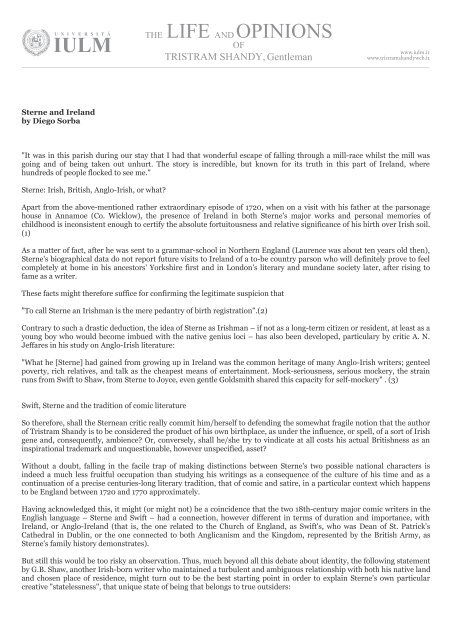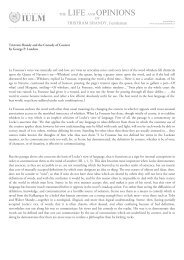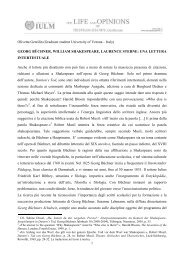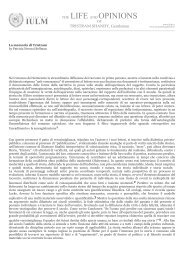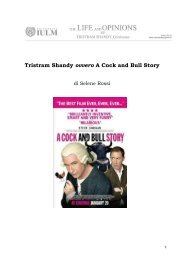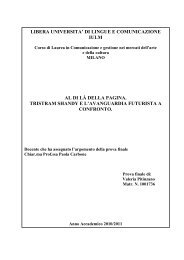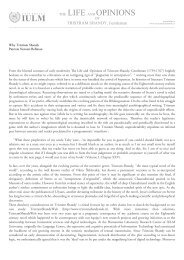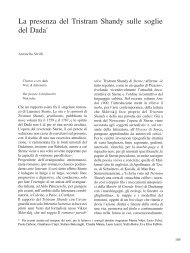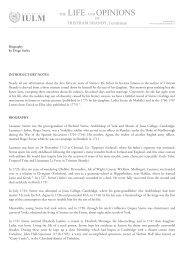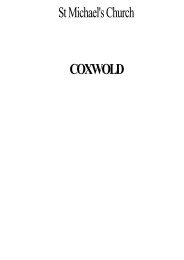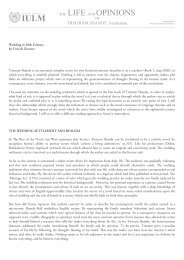Sterne and Ireland by Diego Sorba - The Tristram Shandy Web | IULM
Sterne and Ireland by Diego Sorba - The Tristram Shandy Web | IULM
Sterne and Ireland by Diego Sorba - The Tristram Shandy Web | IULM
You also want an ePaper? Increase the reach of your titles
YUMPU automatically turns print PDFs into web optimized ePapers that Google loves.
www.iulm.it<br />
www.tristramsh<strong>and</strong>yweb.it<br />
<strong>Sterne</strong> <strong>and</strong> Irel<strong>and</strong><br />
<strong>by</strong> <strong>Diego</strong> <strong>Sorba</strong><br />
"It was in this parish during our stay that I had that wonderful escape of falling through a mill-race whilst the mill was<br />
going <strong>and</strong> of being taken out unhurt. <strong>The</strong> story is incredible, but known for its truth in this part of Irel<strong>and</strong>, where<br />
hundreds of people flocked to see me."<br />
<strong>Sterne</strong>: Irish, British, Anglo-Irish, or what?<br />
Apart from the above-mentioned rather extraordinary episode of 1720, when on a visit with his father at the parsonage<br />
house in Annamoe (Co. Wicklow), the presence of Irel<strong>and</strong> in both <strong>Sterne</strong>'s major works <strong>and</strong> personal memories of<br />
childhood is inconsistent enough to certify the absolute fortuitousness <strong>and</strong> relative significance of his birth over Irish soil.<br />
(1)<br />
As a matter of fact, after he was sent to a grammar-school in Northern Engl<strong>and</strong> (Laurence was about ten years old then),<br />
<strong>Sterne</strong>'s biographical data do not report future visits to Irel<strong>and</strong> of a to-be country parson who will definitely prove to feel<br />
completely at home in his ancestors' Yorkshire first <strong>and</strong> in London's literary <strong>and</strong> mundane society later, after rising to<br />
fame as a writer.<br />
<strong>The</strong>se facts might therefore suffice for confirming the legitimate suspicion that<br />
"To call <strong>Sterne</strong> an Irishman is the mere pedantry of birth registration".(2)<br />
Contrary to such a drastic deduction, the idea of <strong>Sterne</strong> as Irishman – if not as a long-term citizen or resident, at least as a<br />
young boy who would become imbued with the native genius loci – has also been developed, particulary <strong>by</strong> critic A. N.<br />
Jeffares in his study on Anglo-Irish literature:<br />
"What he [<strong>Sterne</strong>] had gained from growing up in Irel<strong>and</strong> was the common heritage of many Anglo-Irish writers; genteel<br />
poverty, rich relatives, <strong>and</strong> talk as the cheapest means of entertainment. Mock-seriousness, serious mockery, the strain<br />
runs from Swift to Shaw, from <strong>Sterne</strong> to Joyce, even gentle Goldsmith shared this capacity for self-mockery" . (3)<br />
Swift, <strong>Sterne</strong> <strong>and</strong> the tradition of comic literature<br />
So therefore, shall the <strong>Sterne</strong>an critic really commit him/herself to defending the somewhat fragile notion that the author<br />
of <strong>Tristram</strong> Sh<strong>and</strong>y is to be considered the product of his own birthplace, as under the influence, or spell, of a sort of Irish<br />
gene <strong>and</strong>, consequently, ambience? Or, conversely, shall he/she try to vindicate at all costs his actual Britishness as an<br />
inspirational trademark <strong>and</strong> unquestionable, however unspecified, asset?<br />
Without a doubt, falling in the facile trap of making distinctions between <strong>Sterne</strong>'s two possible national characters is<br />
indeed a much less fruitful occupation than studying his writings as a consequence of the culture of his time <strong>and</strong> as a<br />
continuation of a precise centuries-long literary tradition, that of comic <strong>and</strong> satire, in a particular context which happens<br />
to be Engl<strong>and</strong> between 1720 <strong>and</strong> 1770 approximately.<br />
Having acknowledged this, it might (or might not) be a coincidence that the two 18th-century major comic writers in the<br />
English language – <strong>Sterne</strong> <strong>and</strong> Swift – had a connection, however different in terms of duration <strong>and</strong> importance, with<br />
Irel<strong>and</strong>, or Anglo-Irel<strong>and</strong> (that is, the one related to the Church of Engl<strong>and</strong>, as Swift's, who was Dean of St. Patrick's<br />
Cathedral in Dublin, or the one connected to both Anglicanism <strong>and</strong> the Kingdom, represented <strong>by</strong> the British Army, as<br />
<strong>Sterne</strong>'s family history demonstrates).<br />
But still this would be too risky an observation. Thus, much beyond all this debate about identity, the following statement<br />
<strong>by</strong> G.B. Shaw, another Irish-born writer who maintained a turbulent <strong>and</strong> ambiguous relationship with both his native l<strong>and</strong><br />
<strong>and</strong> chosen place of residence, might turn out to be the best starting point in order to explain <strong>Sterne</strong>'s own particular<br />
creative "statelessness", that unique state of being that belongs to true outsiders:
"When I say that I am an Irishman I mean that I was born in Irel<strong>and</strong>, <strong>and</strong> that my native language is the English of Swift<br />
<strong>and</strong> not the unspeakable jargon of the mid-nineteenth century newspapers". (4)<br />
If we must recognize such a peculiarity as "the English of Swift", we can definitely also acknowledge the existence of an<br />
"English of <strong>Sterne</strong>" (<strong>and</strong> centuries later, also that "of Shaw", "of Joyce", "of Beckett", etc., for that matter). Language is<br />
what makes <strong>Sterne</strong> truly extraordinary, <strong>and</strong> the vis comica <strong>and</strong> creativeness he shares with Swift is not just a fatal<br />
coincidence (although nothing more than that, in terms of birthplaces), but the true milestone of 18th-century English<br />
comic writing.<br />
In this perspective, <strong>Sterne</strong> too could not st<strong>and</strong> "the unspeakable jargon" <strong>and</strong> the "unbearable" structure of mid-eighteenth<br />
century official English novels, <strong>and</strong> thus opted for a freer language <strong>and</strong> form, revolutionary <strong>and</strong> utterly modern. Knowing<br />
that language is certainly to be considered as one of the most complex <strong>and</strong> challenging, however "cheap", means of<br />
entertainment available to humanity, <strong>Sterne</strong>-Yorick is proud to acknowledge that no doubt his story may well be defined<br />
as surrealistic or foolish, but surely nobody could ever possibly dare to complain about it not having been told beautifully<br />
<strong>and</strong> in a most unforgettable way. (5)<br />
<strong>Sterne</strong>'s influence on modern Irish writers<br />
In conclusion, what is important to underline here is the consistent fact that <strong>Sterne</strong>'s influence has left a deep mark, under<br />
the shape of a sort of retroactive heritage based principally upon language experimentation, on many modern writers, <strong>and</strong><br />
that a significant number of them happen to be Irish (underst<strong>and</strong>ably, or accidentally so, hair-splitting identity-hunters<br />
would say).<br />
As Terry Eagleton has duly pointed out,<br />
"<strong>The</strong> Irish novel from <strong>Sterne</strong> to O'Brien is typically recursive <strong>and</strong> diffuse, launching one r<strong>and</strong>om narrative only to abort it,<br />
for some equally gratuitous tale, ringing pedantically ingenious variations on the same meagre clutch of plot elements.<br />
Anglo-Irish literature begins with one of the world's greatest anti-novels [“<strong>Tristram</strong> Sh<strong>and</strong>y”], <strong>and</strong> achieves its apotheosis<br />
in a couple of others". (6)<br />
If readers all over the world have <strong>by</strong> now become familiar with Leopold Bloom's peregrinations <strong>and</strong> digressions in Joyce's<br />
Ulysses, for example, they are probably much less acquainted with that other “couple of” <strong>Sterne</strong>sque XXth-century Irish<br />
novels. In this respect, Flann O'Brien's incipit of At Swim-Two-Birds evidently draws on <strong>Sterne</strong>'s authoritative examples<br />
concerning the art of destructurizing the plot, <strong>and</strong> is hopefully the best example to enhance a further look at some modern<br />
Irish authors who can be closely associated to <strong>Sterne</strong> in this section's Net Resources.<br />
Flann O'Brien, At Swim-Two-Birds (1939)<br />
HAVING placed in my mouth sufficient bread for three minutes' chewing, I withdrew my powers of sensual perception<br />
<strong>and</strong> retired into the privacy of my mind, my eyes <strong>and</strong> face assuming a vacant <strong>and</strong> preoccupied expression. I reflected on<br />
the subject of my spare-time literary activities. One beginning <strong>and</strong> one ending for a book was a thing I did not agree with.<br />
A good book may have three openings entirely dissimiliar <strong>and</strong> inter-related only in the prescience of the author, or for that<br />
matter one hundred times as many endings.<br />
Examples of three separate openings - the first:<br />
<strong>The</strong> Pooka MacPhellimey, a member of the devil class, sat in his hut in the middle of a firwood meditating on the nature of<br />
numerals <strong>and</strong> segregating in his mind the odd ones from the even. He was seated at his diptych or ancient two-leaved<br />
writing-table with inner sides waxed. His rough long-nailed fingers toyed with a snuff-box of perfect rotundity <strong>and</strong><br />
through a gap in his teeth he whistled a civil cavatina. He was a courtly man <strong>and</strong> received honour <strong>by</strong> reason of the<br />
generous treatment he gave his wife, one of the Corrigans of Carlow.<br />
<strong>The</strong> second opening:<br />
<strong>The</strong>re was nothing unusual in the appearance of Mr John Furriskey but actually he had one distinction that is rarely<br />
encountered - he was born at the age of twenty-five <strong>and</strong> entered the world with a memory but without personal experience<br />
to account for it. His teeth were well formed but stained <strong>by</strong> tobacco, with two molars filled <strong>and</strong> a cavity threatened in the<br />
left canine. His knowledge of physics was moderate <strong>and</strong> extended to Boyle's Law <strong>and</strong> the Parallelogram of Forces.<br />
<strong>The</strong> third opening:<br />
Finn Mac Cool was a legendary hero of old Irel<strong>and</strong>. Though not mentally robust, he was a man of superb physique <strong>and</strong><br />
development. Each of his thighs was as thick as a horse's belly, narrowing to a calf as thick as the belly of a foal. Three<br />
fifties of fosterlings could engage with h<strong>and</strong>ball against the wideness of his backside, which was large enough to halt the<br />
march of men through a mountain-pass. […]
Notes<br />
(1) "Few of his contemporaries were aware that Laurence <strong>Sterne</strong> had been born in Irel<strong>and</strong>. Though the memoir written for<br />
Lydia draws attention to the fact, <strong>Sterne</strong> only mentioned his Irish background in one letter; denying at length a report that<br />
he had ‘ridiculed my Irish friends at Bath' in 1765, he concluded: ‘Besides, I am myself of their own country: - My father<br />
was a considerable time on duty with his regiment in Irel<strong>and</strong>; <strong>and</strong> my mother gave me to the world when she was there'<br />
" (ROSS, Ian Campbell, Laurence <strong>Sterne</strong>: A Life, Oxford: Oxford University Press, 2001, 436, n. 35).<br />
(2)Arthur Clery, Irish Essays (1919), quoted in Field Day Anthology, gen. ed. S. Deane (Derry: Field Day, 1991, Vol. 2,<br />
p.1006). Also W.B.Yeats seemed rather sceptical about acknowledging <strong>Sterne</strong>'s Irishness, just as much as he was with the<br />
cases of Swift <strong>and</strong> of philosophers George Berkeley <strong>and</strong> Arl<strong>and</strong> Ussher – see letter to E. Dowden (8 March 1895), in<br />
YEATS, W. B., Collected Letters, vol. 1 – 1865-1895, ed. J. Kelly (Oxford: OUP, 1986).<br />
(3) JEFFARES, A. N., Anglo-Irish Literature (London: Macmillan, 1982, pp. 53-54).<br />
(4) SHAW, G. B., preface to John Bull's Other Isl<strong>and</strong> (1904).<br />
(5) “L--d! said my mother, what is all this story about? – A COCK <strong>and</strong> a BULL, said Yorick – And one of the best of its kind<br />
I ever heard” (<strong>Tristram</strong> Sh<strong>and</strong>y, Vol. IX, Ch. XXXII).<br />
(6) EAGLETON, T., ‘Form <strong>and</strong> Ideology in the Anglo-Irish Novel', in M. Massoud, ed., Literary Relations: Irel<strong>and</strong>, Egypt<br />
<strong>and</strong> the Far East (Gerrards Cross: Colin Smythe, 1996, pp.135-46).


